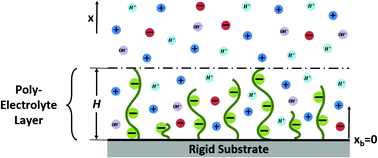Revisiting the strong stretching theory for pH-responsive polyelectrolyte brushes: effects of consideration of excluded volume interactions and an expanded form of the mass action law
Abstract
In this paper, we develop a theory to account for the effect of excluded volume (EV) interactions in the strong stretching theory (SST) based description of pH-responsive polyelectrolyte (PE) brushes. The existing studies have considered the PE brushes to be present in a θ-solvent and hence have neglected the EV interactions; however, such a consideration cannot describe the situations where the pH-responsive brushes are in a “good” solvent. Secondly, we consider a more expanded form of the mass action law, governing the pH-dependent ionization of the PE molecules, in the SST description of the PE brushes. This expanded form of the mass action law considers different values of γa3 (γ is the density of chargeable sites on the PE molecule and a is the PE Kuhn length) and therefore is an improvement over the existing SST models of PE brushes as well as other theories involving pH-responsive PE molecules that always consider γa3 = 1. Our results demonstrate that the EV effects enhance the brush height by inducing additional PE inter-segmental repulsion. Similarly, the consideration of the expanded form of the mass action law would lead to a reduced (enhanced) brush height for γa3 < 1 (γa3 > 1). We also quantify variables such as the monomer density distribution, the distribution of the ends of the PE brush, and the EDL electrostatic potential and explain their differences with respect to those obtained with no EV interactions or γa3 = 1.



 Please wait while we load your content...
Please wait while we load your content...
